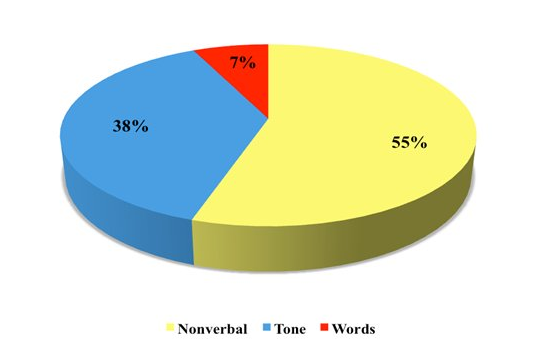Abstract
In the world of technologies of today, it may seem that the significance of face-to-face communication is fading since it is becoming an outdated form of interaction. In fact, thousands of people may spend days and even weeks without actually talking to anyone in person. It is often argued that the convenience of text messaging, emails, and social networks has drastically changed people’s attitude to personal communication, which is likely to lead to its disappearance (Duncan & Fiske, 2015). However, the present paper argues (without denying the importance of modern technologies), that face-to-face communication should be present in our lives due to such advantages as clarity and effectiveness, personal touch, non-verbal cues, and emotional involvement.
In the digital age of today, technology may seem to have made face-to-face communication an outdated form of interaction, which makes its significance fade away. Indeed, modern modes of interaction via electronic devices have considerably changed our perception of time and distance as they make it possible for people to communicate and collaborate without changing their location. Plenty of employees prefer working from home so that thousands of people may spend days and even weeks without actually talking to anyone in person. However, despite some evident advantages provided by modern ways of interaction, there exist certain aspects, in which face-to-face communication cannot be surpassed and, therefore, should not be undervalued either in shaping business outcomes or in resolving personal issues. The paper at hand is going to present the key advantages of face-to-face communication.
Clarity and Effectiveness
It is not infrequent for emails and text messages to be misread or misunderstood as the addressee sees another communicative intention in them. The risk of miscommunication is minimized by face-to-face interactions as its clarity is much higher. Furthermore, if any misunderstanding arises, the immediacy of interaction will allow clarifying vague or ambiguous points to the interlocutor. This implies that face-to-face communication can boast of greater efficiency and effectiveness (Schulze, Schultze, West, & Krumm, 2017). Instead of spending hours on emails, specifying details, it is enough to have a one-minute real conversation, which will make things clear. Besides, it may be helpful to those who are not fluent in writing.
Personal Touch
The so-called personal touch is important both in private and business interactions as it allows feeling each other’s engagement in the issue under discussion. The problem with computer-mediated communication is that it may sound too impersonal, particularly in business contexts. Following the prescribed form of business correspondence, partners too often forget about the importance of the personal touch, which leads to failed compromises or even conflicts as no one is willing to see a real individual behind the written text. Effective organization leaders must foster face-to-face communication and encourage employees to take part in meetings and various social events in order to build a collaborative environment, which fosters engagement and creates a more human-oriented approach (Richards & Schmidt, 2014).
Non-verbal Cues

Despite the common delusion that the major bulk of information is transferred with the help of words, in fact, as it is shown in Figure 1, we use more non-verbal cues than words. Messaging deprives people of the ability to see the body language of the interlocutor, which may be misleading and make them an easy target for cheating (Burgoon et al., 2016). The tone of one’s voice cannot be adjusted via emails and may be misinterpreted by the respondent, especially in case of short replies (simple “yes” or “no” might appear to be rude or friendly). Non-verbal cues, therefore, make it possible not only to receive more information but also to avoid errors of judgment.
Emotional Involvement
The success of both personal and business relationships largely depends on the emotional involvement of the parties. Although communication via technologies has gone far beyond talking business and is now equally used for private messaging, it is still challenging to express emotions in this way, even using smileys, stickers, and other forms of visualization (a smiley is not yet a smile) (Shalom, Israeli, Markovitzky, & Lipsitz, 2015). Furthermore, it is quite impossible to predict possible reactions of the addressee since such forms of visualization may be displayed differently depending on the platform. Since they are unacceptable in business communication, it becomes quite impossible for partners to express their attitude to each other (even in cases when it is necessary to be less neutral than usual) (Rouhshad, Wigglesworth, & Storch, 2016). Thus, face-to-face communication gives an unquestionable benefit of emotional self-expression.
Conclusion
In the world of rapidly progressing technologies, it is rather hard to avoid involving in remote interactions via electronic platforms. These forms of communication have a number of advantages that make them gain popularity. It is often argued that the convenience of text messaging, emails, and social networks has drastically changed people’s attitude to personal communication, which is likely to lead to its disappearance (Duncan & Fiske, 2015). However, the latter still features some important benefits (such as clarity and effectiveness, personal touch, non-verbal cues, and emotional involvement) that make it superior in a number of aspects.
References
Burgoon, J. K., Guerrero, L. K., & Floyd, K. (2016). Nonverbal communication. London, UK: Routledge.
Duncan, S., & Fiske, D. W. (2015). Face-to-face interaction: Research, methods, and theory. New York, NY: Routledge.
Richards, J. C., & Schmidt, R. W. (2014). Language and communication. New York, NY: Routledge.
Rouhshad, A., Wigglesworth, G., & Storch, N. (2016). The nature of negotiations in face-to-face versus computer-mediated communication in pair interactions. Language Teaching Research, 20(4), 514-534.
Schulze, J., Schultze, M., West, S. G., & Krumm, S. (2017). The knowledge, skills, abilities, and other characteristics required for face-to-face versus computer-mediated communication: Similar or distinct constructs? Journal of Business and Psychology, 32(3), 283-300.
Shalom, J. G., Israeli, H., Markovitzky, O., & Lipsitz, J. D. (2015). Social anxiety and physiological arousal during computer-mediated vs. face-to-face communication. Computers in Human Behavior, 44(1), 202-208.
